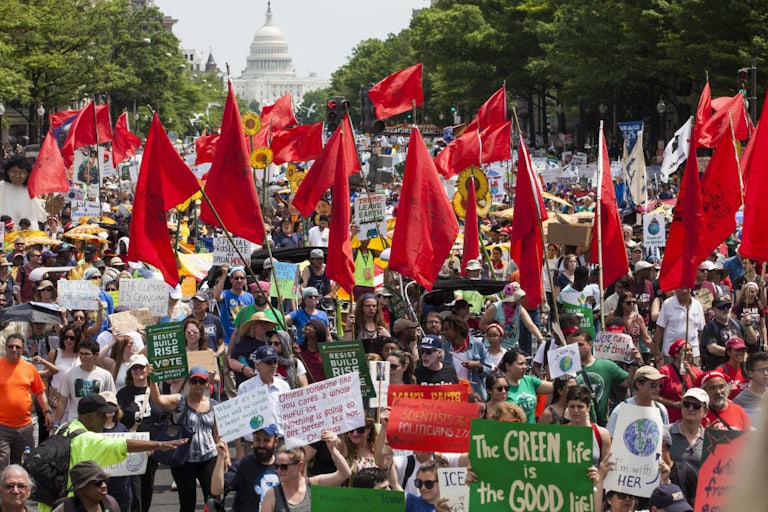Worried About the Climate? Get Off the Couch. The Data Supports It.
Activism isn’t just the “antidote to despair.” A growing body of research suggests it’s also pretty effective at changing the world.

In the wake of the election, many discouraged leftists announced they were tuning out. Two months into Donald Trump’s presidency, however, the case for sitting on the sofa and drowning anxieties in escapist television is getting slimmer. And that’s especially true for people concerned about the climate crisis, who are often presumed to be at particular risk of despair and burnout.
“Action is the antidote to despair,” Joan Baez famously said, a line frequently quoted in climate circles. It’s not just an inspirational meme: There’s now a growing body of evidence that climate protest works—not just to decrease anxiety in your head but to change the world outside of it. And contrary to all the stereotypes about preachy greenies putting other people off the cause, there doesn’t seem to be much risk of provoking backlash.
When researchers working with the Yale Program on Climate Change Communication reviewed 50 recent studies on the impact of climate activism for an article published last week, they found “strong evidence that climate activism shifts public opinion and media coverage in a pro-climate direction.” They also found evidence that activism can sway policymakers and increase the percentage of vote share going to pro-climate candidates. One particularly intriguing study from Germany found not only that “areas that were exposed to protests had a higher share of the vote (+2-2.5% points) go to the Green party,” but also that “repeated exposure [i.e., more protests] increased this effect.”
The ubiquitous fear that the wrong types of protest might turn people off, on the other hand, doesn’t seem very well supported. “We’re beginning to think that concerns about backlash are a bit overstated, generally,” lead author Laura Thomas-Walters told me over Zoom, noting that this trend held both for climate protest and for political messaging in general. Even if the public objects to certain activism, like people vandalizing artwork or monuments, that doesn’t mean that particular group turns them off the climate cause in general.
Cautioning that she was speaking for herself and not necessarily for the other authors, Thomas-Walters said that “there will be some people who get pissed off, but they’ll be pissed off no matter what you do. If you mention you’re vegan, they’ll say I’m going to eat two steaks tonight just to spite you.” The review also found recent evidence that more extreme actions can actually increase support for moderate climate groups, in what’s known as the “radical flank effect.” This is a known phenomenon that goes back decades and isn’t just about climate activism. “There’s a good argument,” Thomas-Walters said, “that Martin Luther King wouldn’t have been so successful if it wasn’t for Malcolm X making him look a lot more moderate than he basically was.”
This research comes at a complicated time for activism in the U.S. Protest against the Trump administration and Elon Musk is growing, and seems to be having an effect. But moves to suppress and even criminalize protest are growing, as well. Earlier this week, TNR’s Kate Aronoff wrote about the proliferating signs that the administration is cracking down not just on pro-Palestine demonstrators but on activists of all stripes. The recent verdict holding environmental group Greenpeace liable for the company Energy Transfer’s expenses due to the Dakota Access Pipeline protests has also rocked the environmental movement.
At the same time, the evidence that engagement can help people struggling with their anxiety about current events and the environment keeps building. And the YPCC review now adds more information about how activism functions in the broader world.
“One of the reasons I did this review, personally, is because I’m also a climate activist in the U.K.,” said Thomas-Walters, who’s a member of Extinction Rebellion. “You are relying on people’s limited attention and energy and money and stuff,” so having data about what works is useful. “Activists and people get burned out, so we want to be as effective as we can.”
I asked her whether she had a sense of what U.S. activists, in particular, might take away from this review. Much of the evidence this review included, even research from Europe, she said, should “apply relatively well to a lot of the Western world,” and some of it came specifically from the U.S. And she pointed to one other thing that U.S. climate activists might want to focus on in this moment: “With Trump in power, we’ve seen some evidence of successful climate stuff that’s happening on the local scale, and I think building that deeper community of activists on a local area and being able to achieve local wins might be a good way to keep people going.”
Stat of the Week
40% poorer
That’s the hit the average person will take if the world warms by four degrees Celsius, according to a new study.
What I’m Reading
Pension Funds Push Forward on Climate Goals Despite Backlash
Banks are scrapping their climate goals left and right. But pension funds, Eshe Nelson reports, are taking a different approach—and their investing power shouldn’t be discounted.
At a time of growing backlash to environmental, social and governance goals and investment strategies, pension funds, particularly in blue states and Europe, have emerged as a bulwark against efforts to sideline climate-related risks.
The funds, which sit at the top of the investment chain, have stepped up engagement with asset managers and companies on climate goals and have kept public commitments to use their fiscal might to reduce carbon emissions. In some cases, that has meant shifting to European asset managers, which have not backed off on climate commitments as much as their American counterparts have.
[NYC Comptroller Brad] Lander’s office oversees investments for five public pension funds for 700,000 of the city’s current and former employees. The funds are pushing ahead with engagement, bringing more shareholder resolutions to banks to disclose the ratio of their fossil fuel investments versus clean energy and to utilities companies on their climate targets.
Read Eshe Nelson’s full report at The New York Times.
This article first appeared in Life in a Warming World, a weekly TNR newsletter authored by deputy editor Heather Souvaine Horn. Sign up here.









